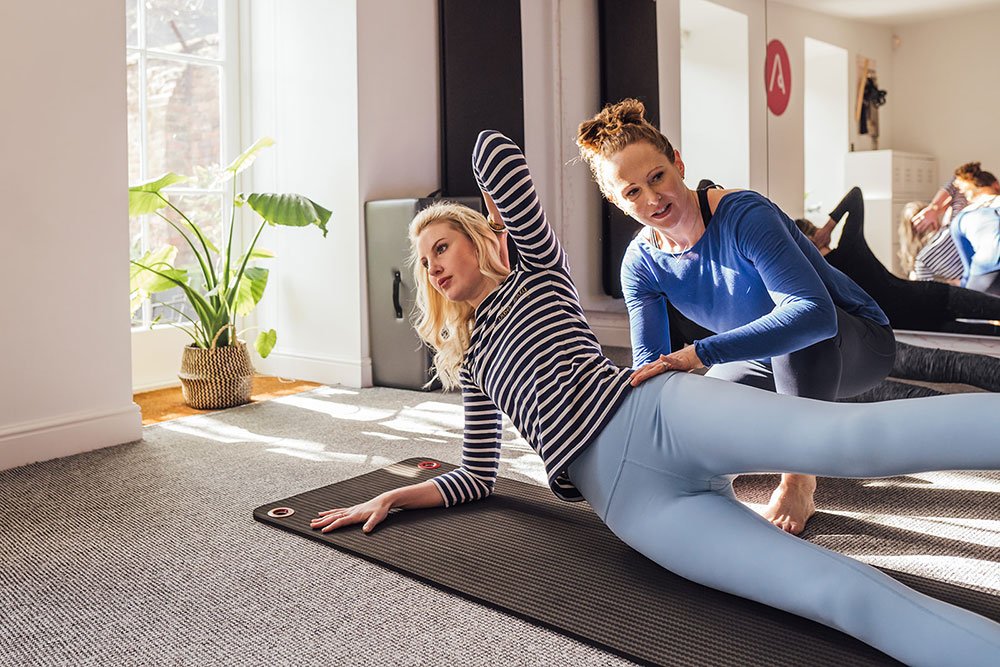All you need to know about the Pilates Side Kick
Ever wondered ‘why’ about some of the Pilates moves you do in class? Behind the Moves is our series of expert Pilates insights explaining the Pilates movements. Lauren Hilton delves a little deeper into a move per month so you can learn the benefits of the movements we’re offering our bodies and what those mean for our day-to-day movement and well-being.
What is the Pilates side kick?
As it states, you’re on your side, we’re weight-bearing in the shoulder with head, ribs, and pelvis in a straight line and then we’re kicking the leg forward and back. Sounds simple enough right?!
Like with any movement practice, it’s when we understand the layers that we can really feel the depth of a movement, how it feels to be in ‘correct alignment’, and ultimately then use the intended muscles. Remember, the movement activates the muscles, not the other way around but in order to achieve this we need good alignment.
PILATES SIDE KICK practices moving the leg without changing the alignment of the rest of the body.
What’s the point of the Pilates side kick?
Like all of Pilates movements, there are layers to the sidekick. The side kick starts with side-lying (a pre-Pilates exercise), you’re close to the ground with your head on a block and the whole underside of the body supported and therefore you have more base of support and therefore the movement is a little easier. It’s where you find good alignment as a beginner, where you find your stability and the all-important control. Sure we can fling our leg in the air and take it as high as we can but what happens to our pelvic alignment, does the waist and ribs drop into the floor, if so you’ll need to adapt the range of movement. We’re looking to move the leg without changing the alignment of the rest of the body. It’s a great way to practice core control in a side-lying orientation.
THE PILATES SIDE KICK helps create a balance between the front and back of our bodies.
Why is the side kick a great movement to work on?
Many other methods of exercise only work in the sagittal plane of movement, that’s movements that go forwards and backward in non-anatomical language, for example walking, running, squats, bench presses, rows, and cycling. Sagittal movements in our bodies are the most common in our bodies. However coronal/frontal planes of movement are less common, examples of coronal movements are things like side lunges, side bends, lateral arm raises, or jumping jacks. They’re movements that are directed away and towards the centre of our bodies but sideways. It’s important we train our muscles in all planes of movement in order to create a balance between the front and back of our bodies. Enter side kick! We have to orientate our bodies, precariously balanced on the sides of ourselves, and then move the leg in the sagittal plane and once we’ve mastered this there are leg circles, raises, and developpe passé variations too!
In fact, the Pilates mat repertoire and the apparatus repertoire is teeming with exercises that work your side body…mermaid, book openings, side lying, side kick, kneeling side kick, standing leg series on the reformer, side arms on eve reformer, side lift, star the list is endless! Another reason why the Pilates method is a fully-rounded workout for our mind and body!
The Pilates side kick illustrated in Pilates Anatomy by Rael Isacowitz & Karen Clippinger
What muscles are working then?
Well, if we’re doing the exercise correctly then our entire body is working. I love these illustrations from Rael Isacowitz’s book (above) as they give a guide as to what muscles are working. Traditionally, it was taught with both hands behind the head but this doesn’t always create great shoulder support.
I feel like I’m going to fall back when I kick back, what am I doing wrong?
This is what I see happening most in classes, it’s the kick back when the control is lost, it’s a side-lying core exercise so we need the control of the trunk. Exhale as you kick back and think about keeping your front ribs connected to your back ribs. The abdominals keep the connection between your ribs and pelvis still and stable. Try bending the bottom leg if you need to, this is a great way of learning the movement and finding stability.
Try side lying exercises each time you do your Pilates workout or attend a class. It’ll help balance your body front and back and help build strength in the muscles along the side of your body.
This blog is designed to educate; we believe knowledge is power and with a deeper understanding of our body we can live in a happier, healthier, and pain-free body.
No one body is the same (thank goodness!) so the information provided may not be appropriate for you. If you’d like to know more about the Hundred or want to dive in deeper, why not consider booking a one-to-one Pilates session?
Lauren Hilton Pilates is a boutique Pilates studio specialising in mindful Pilates movement. Located in the heart of Shrewsbury, our fully equipped studio has the ultimate Pilates experience for you. Our class blocks are released each term (and fill up quickly). To be one of the first to receive our booking alerts, subscribe to our emails. Check out all our classes to find one that suits you where you are.
New to Pilates?
Our Beginners Course is a perfect introduction to Pilates.
Can’t get to the studio or prefer to work out at home?
Lauren Hilton Pilates At Home is made for you, with over 120 classes to choose from and 5 new classes each month.
See you in the studio or online studio soon!
Lauren x
Owner and Pilates teacher, Lauren Hilton Pilates, Shrewsbury
Photo credit: Florence Fox Photography





